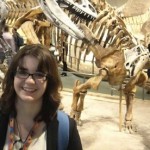Sensitivity of precipitation isotope meteoric water lines and seasonal signals to sampling frequency and location
 This work is being conducted by undergraduate lab member, Allison Reynolds. Allison presented her work as part of the CUAHSI/USGS Virtual Workshop on applications of laser specs to hydrology and biogeochemistry. From that workshop, she will have an extended abstract published in a USGS open file report, and her poster will continue to be viewable on-line. She will also be presenting results at the inaugural Kent State Undergraduate Research Symposium in April. And of course, she’s going to keep working on new data and analyses and aiming for publication. Go Aly!
This work is being conducted by undergraduate lab member, Allison Reynolds. Allison presented her work as part of the CUAHSI/USGS Virtual Workshop on applications of laser specs to hydrology and biogeochemistry. From that workshop, she will have an extended abstract published in a USGS open file report, and her poster will continue to be viewable on-line. She will also be presenting results at the inaugural Kent State Undergraduate Research Symposium in April. And of course, she’s going to keep working on new data and analyses and aiming for publication. Go Aly!
Sensitivity of precipitation isotope meteoric water lines and seasonal signals to sampling frequency and location
Allison R. Reynolds (areyno13@kent.edu) and Anne J. Jefferson (advisor)
Department of Geology, Kent State University, Kent, OH 44242
Our purpose is to compare seasonal signal and local meteoric water line (LMWL) generated by analyzing hydrogen and oxygen isotopes in precipitation for one year of event-based sampling to those from multi-year monthly sampling at the closest Global Network of Isotopes in Precipitation (GNIP) stations. The question we seek to answer is whether data from different sampling strategies, periods, and locations within the eastern Great Lakes region on a regional-scale LMWL and seasonal signal. We collected precipitation samples after each event in Kent, OH. Samples were analyzed with a Picarro L-2130i. The closest GNIP sites are Coshocton, Ohio and Simcoe, Ontario. LMWLs and seasonal signals derived from monthly samples were broadly similar along a 300 km north-south transect in the US eastern Great Lakes Region. Monthly volume-weighted averages of event precipitation under-represent event scale isotopic variability, based on samples from Kent, Ohio.
